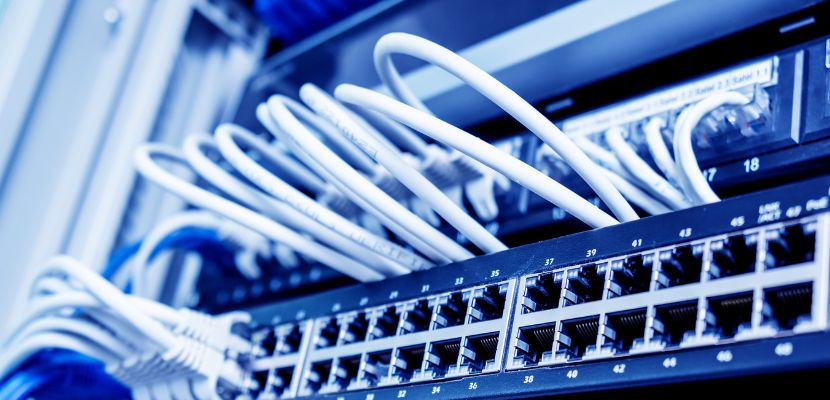A packet-switched network is a type of digital network in which data is broken into smaller units called packets before being transmitted.

What Is a Packet-Switched Network?
A packet-switched network is a communication network that transmits data by dividing it into small units called packets. Each packet contains both payload data and control information, such as source and destination addresses. These packets are transmitted independently and can take different routes through the network, depending on factors like congestion and availability of nodes.
Upon arrival at the destination, the packets are reassembled in the correct order to reconstruct the original message. Packet switching optimizes bandwidth usage, reduces latency under light traffic conditions, and supports multiple simultaneous communications on the same network infrastructure. It forms the foundation of most modern data networks, including local area networks (LANs) and the internet.
Packet-Switched Network Key Components
Here are the key components of a packet-switched network, each playing a vital role in data transmission:
- Packets. Small units of data that include both payload and control information (like source, destination, and sequence number) for routing and reassembly.
- Nodes (routers and switches). Intermediate devices that read packet headers and determine the best path for forwarding each packet toward its destination.
- Links (transmission media). Physical or wireless connections that carry packets between nodes, such as fiber optics, copper cables, or radio signals.
- Protocols. Rules that govern how packets are formatted, transmitted, routed, and reassembled (e.g., IP, TCP, UDP).
- Routing tables. Databases within routers that store information about paths through the network, enabling efficient packet forwarding.
- End devices (hosts). Computers, servers, or mobile devices that generate, send, receive, and interpret the packet data.
How Does Packet-Switched Network Work?

A packet-switched network works by breaking data into small units called packets before transmission. Each packet contains a portion of the original data along with control information, such as source and destination addresses, sequencing details, and error-checking codes. These packets are then sent independently through the network and may take different routes based on current traffic conditions, network topology, and routing algorithms.
Routers and switches at intermediate nodes read the control information and forward the packets toward their destination using routing tables. Once all packets arrive at the destination device, they are reassembled in the correct order to reconstruct the original message. This dynamic, decentralized approach allows efficient use of network resources, supports multiple users simultaneously, and increases resilience to failures or congestion.
What Is Packet-Switched Network Used For?
Packet-switched networks are used for transmitting data efficiently across digital communication systems, especially where flexibility, scalability, and resource optimization are critical. They form the foundation of the internet and are commonly used for web browsing, email, file transfers, streaming media, and online gaming.
These networks also support enterprise applications, cloud services, and Voice over IP (VoIP) by enabling multiple data streams to share the same infrastructure without the need for dedicated circuits. Their ability to dynamically route packets and handle varying traffic loads makes them ideal for both public and private data communication across diverse environments.
Types of Packet-Switching
Here are the main types of packet switching, each with distinct mechanisms for handling data transmission.
1. Datagram Packet Switching
In datagram packet switching, each packet is treated independently, with no predefined path. The network routes each packet dynamically based on the current routing information and network conditions. As a result, packets may arrive out of order, take different paths, or even be dropped. This type is used in connectionless protocols like UDP and is the basis for how the Internet functions.
2. Virtual Circuit Packet Switching
Virtual circuit packet switching establishes a pre-defined path (a "virtual circuit") before any packets are transmitted. Although the path is virtual and not physically dedicated, all packets follow the same route and are delivered in order. This approach combines the benefits of packet-switching efficiency with some of the predictability of circuit switching. Protocols like TCP and technologies like MPLS often use this method.
3. Label Switching (e.g., MPLS)
Label switching, such as in multi-protocol label switching (MPLS), is a hybrid form that combines aspects of virtual circuits with high-speed packet forwarding. Instead of using IP addresses for routing, packets are assigned short labels that determine their path through the network. This method increases speed and ensures quality of service (QoS) for critical applications.
Packet-Switched Network Examples
Here are a few common examples of packet-switched networks:
- The internet. The most widespread example, where data (web pages, emails, videos) is broken into packets and routed across multiple networks to reach users worldwide.
- Local area networks (LANs). Office or campus networks that use Ethernet or Wi-Fi to transmit packets between computers, printers, and servers.
- 4G/5G mobile networks. Modern cellular networks that rely on packet switching to deliver voice (via VoIP), text, and data services efficiently.
- MPLS networks. Used by enterprises and service providers to create virtual circuits with packet-switching efficiency and traffic engineering capabilities.
- Voice over IP (VoIP). Services like Teams or Zoom that transmit voice and video as data packets over IP networks instead of traditional phone circuits.
The Advantages and the Disadvantages of Packet-Switched Networks
Packet-switched networks offer numerous benefits that make them the backbone of modern digital communication, but they also come with certain limitations. Understanding both the advantages and disadvantages helps in evaluating their suitability for various applications and network environments.
What Are the Advantages of Packet-Switched Networks?
Here are the main advantages of packet-switched networks:
- Efficient bandwidth usage. Data from multiple sources can share the same network paths, reducing idle time and maximizing resource utilization.
- Scalability. Networks can easily accommodate more users and higher data volumes without requiring major infrastructure changes.
- Resilience and fault tolerance. Packets can be rerouted around failed or congested nodes, allowing communication to continue even during network issues.
- Cost-effective. Shared infrastructure reduces the need for dedicated circuits, lowering operational and maintenance costs.
- Support for diverse traffic. Suitable for handling various types of data on a single network, such as voice, video, and text.
- Dynamic routing. Routers can adapt paths in real-time based on network conditions, improving performance and reliability.
What Are the Disadvantages of Packet-Switched Networks?
Here are the main disadvantages of packet-switched networks:
- Variable latency. Since packets may take different paths, they can arrive at different times, leading to jitter or delays, especially problematic for real-time applications like voice and video.
- Packet loss. Congested or faulty network paths may cause packets to be dropped, requiring retransmission and potentially degrading performance.
- Out-of-order delivery. Packets can arrive in a different sequence than they were sent, requiring additional processing at the destination to reorder them correctly.
- Increased overhead. Each packet carries control information (headers), which adds overhead and slightly reduces overall data throughput.
- Security risks. Without proper security measures, the open and dynamic nature of packet switching can make networks more vulnerable to interception, spoofing, and denial-of-service attacks .
What Is the Difference Between Circuit-Switched and Packet-Switched Networks?
Here is a comparison of circuit-switched and packet-switched networks in table format:
| Feature | Circuit-switched network | Packet-switched network |
| Connection establishment | Requires a dedicated path before data transmission. | No dedicated path; packets are routed independently. |
| Resource allocation | Fixed and reserved for the entire session. | Shared among users; allocated dynamically. |
| Data transmission | Continuous, ordered stream. | Broken into packets; may arrive out of order. |
| Efficiency | Less efficient due to idle time in reserved circuits. | More efficient; resources used only when needed. |
| Latency | Low and predictable. | Variable, depending on routing and network congestion. |
| Reliability | High, as the path is constant throughout the session. | Requires error checking and packet reordering. |
| Scalability | Limited; not ideal for large, dynamic traffic loads. | Highly scalable and suited for complex networks. |
| Examples | Traditional telephone networks (PSTN). | Internet, LANs, VoIP, mobile data networks. |